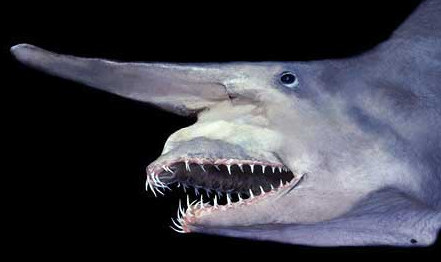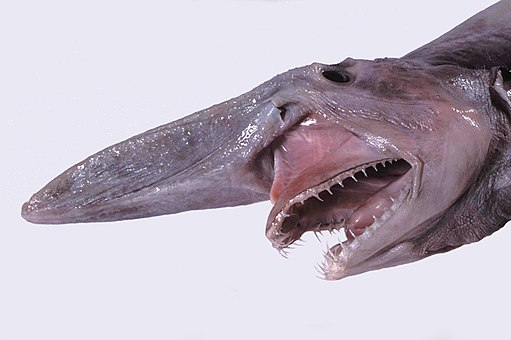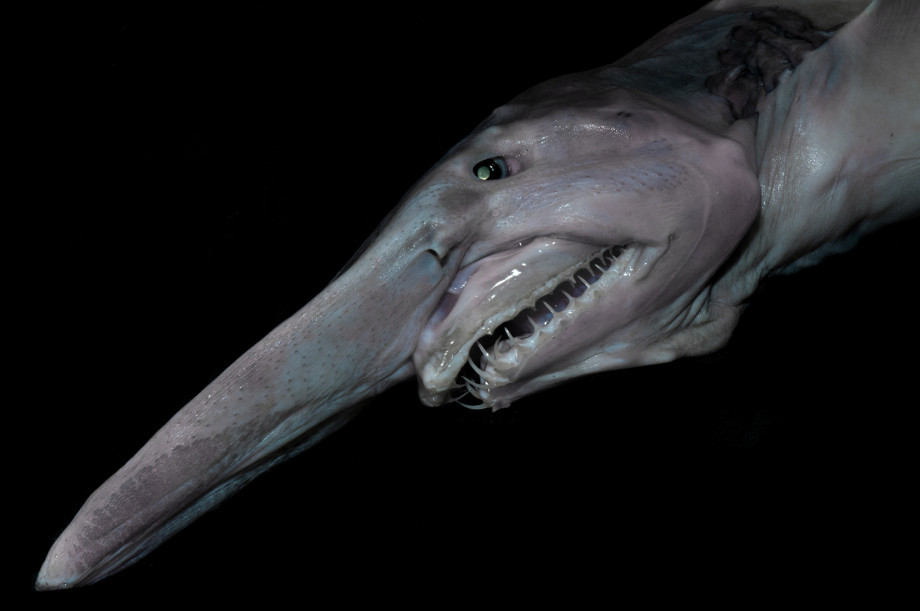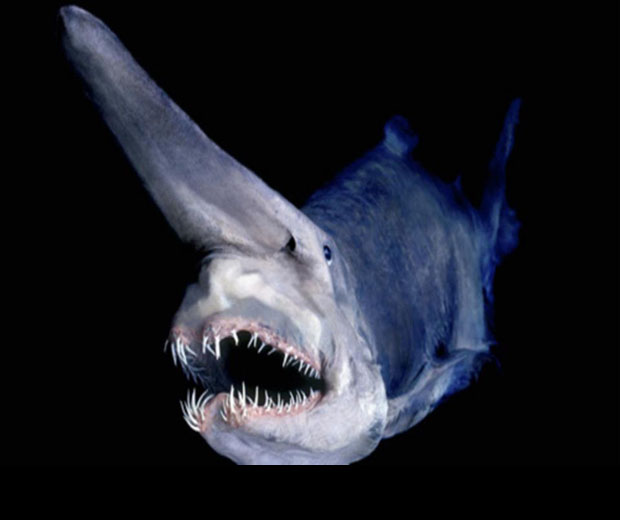 Introduce the Goblin Shark and its mysterious place in the deep-sea
Introduce the Goblin Shark and its mysterious place in the deep-sea
Have you ever heard of the goblin shark? If not, you’re not alone – this deep-sea predator might not be as well-known as great white sharks or hammerheads, but it’s just as fascinating and is one of the most mysterious and elusive creatures on the planet. With its long, protruding jaw and snout and unique coloring, the goblin shark is unlike any other shark you’ve ever seen. Even more intriguing is the fact that very little is known about these creatures, as they live in the depths of the ocean where few humans venture. But despite their mysterious nature, one thing is certain, the goblin shark is a fascinating creature that is definitely worth learning more about.
History of Discovery – Tracking the history of Goblin Shark discovery, from earliest sightings to modern research
- Kingdom: The goblin shark belongs to the kingdom Animalia, which includes all animals. This is the highest and broadest level of classification. It categorizes organisms based on their fundamental characteristics.
- Phylum: The goblin shark falls under the phylum Chordata, which encompasses animals possessing a notochord (a flexible, rod-like structure) at some stage of their life. This level groups organisms based on their anatomical and developmental characteristics.
- Class: The goblin shark belongs to the class Chondrichthyes, which includes cartilaginous fishes such as sharks, rays, and skates. Class further refines the classification by grouping organisms with similar traits. These organisms have skeletons made of cartilage instead of bone.
- Order: The goblin shark is classified in the order Lamniformes, which comprises mackerel sharks, including species like great white sharks and mako sharks. Order classifies organisms based on their shared characteristics and evolutionary relationships.
- Family: The goblin shark belongs to the family Mitsukurinidae, which specifically includes goblin sharks. Family is a taxonomic level that groups related genera together.
- Genus: The goblin shark’s genus is Mitsukurina. Genus represents a more specific classification level, grouping species that share common characteristics and a common ancestor more closely.
- Species: The goblin shark’s scientific name is Mitsukurina owstoni, with “owstoni” denoting the specific epithet given to this particular species. Species is the most specific and fundamental taxonomic level, referring to individual distinct types of organisms.
The Goblin sharks may just be one of the coolest creatures in the ocean. The history of discovering this fascinating species dates back to 1898 when a specimen was first sighted by a Japanese fisherman. It wasn’t until the 1960s that another specimen was caught, allowing for further study and understanding of this mysterious shark. Since then, sightings have been rare and dispersed across different regions of the world. Today, modern research on goblin sharks and other species is ongoing, and scientists are constantly finding new information about these elusive creatures. Some of the fascinating facts we’ve learned are that they can detect their prey using electroreception and that their jaws can be “slingshot” out of their mouths to catch unsuspecting prey. With new technological advancements, we can only imagine what we might discover about these unique sharks in the future.
Physiology and Behavior
 Ever wondered how deep a goblin shark can dive? This mysterious species is well adapted to the depths of the deep sea and can often be found at depths of over 4,000 feet. But how do they manage to survive in such extreme conditions? Goblin Sharks, which can grow to lengths of more than 12 feet, are uniquely adapted with a long, protruding snout and jaw that can extend out to catch prey. This feature allows them to hunt in the dark, murky waters of the deep ocean without relying on sight. Their bodies are also designed to withstand the intense pressure of the deep, with thick skin and a cartilage skeleton that is more flexible than bone. It’s a wonder of adaptation that has allowed the Goblin Shark species to thrive in one of the most extreme habitats on earth.
Ever wondered how deep a goblin shark can dive? This mysterious species is well adapted to the depths of the deep sea and can often be found at depths of over 4,000 feet. But how do they manage to survive in such extreme conditions? Goblin Sharks, which can grow to lengths of more than 12 feet, are uniquely adapted with a long, protruding snout and jaw that can extend out to catch prey. This feature allows them to hunt in the dark, murky waters of the deep ocean without relying on sight. Their bodies are also designed to withstand the intense pressure of the deep, with thick skin and a cartilage skeleton that is more flexible than bone. It’s a wonder of adaptation that has allowed the Goblin Shark species to thrive in one of the most extreme habitats on earth.
Deep Sea Habitat
Exploring the Depths of the Deep-Sea Habitat
 Did you know that the deep-sea habitat is one of the least explored areas on Earth? This vast region, which stretches down to depths of over 19,000 feet (6,000 meters), is home to a stunning array of creatures that have adapted to living in an environment where sunlight doesn’t penetrate. From bioluminescent squids to giant tube worms that harvest energy from hot hydrothermal vents, the deep sea is full of wonders that are waiting to be discovered like the Goblin Shark. While it’s difficult and expensive to explore this dark and remote world, advances in technology are making it easier to unlock its secrets.
Did you know that the deep-sea habitat is one of the least explored areas on Earth? This vast region, which stretches down to depths of over 19,000 feet (6,000 meters), is home to a stunning array of creatures that have adapted to living in an environment where sunlight doesn’t penetrate. From bioluminescent squids to giant tube worms that harvest energy from hot hydrothermal vents, the deep sea is full of wonders that are waiting to be discovered like the Goblin Shark. While it’s difficult and expensive to explore this dark and remote world, advances in technology are making it easier to unlock its secrets.
Investigating the Goblin Shark’s Preferred Environment
Many people have never heard of the goblin shark, but trust me, this shark is one deep-water shark you won’t forget. It’s got a long, flat snout that’s filled with sharp teeth, and it’s capable of extending its jaw out to snatch up its prey. But what kind of environment does this powerful predator prefer? Well, researchers have been investigating just that. They’ve found that goblin sharks tend to stick to deep waters, around 1,000-4,000 feet deep, and they’re often found near submarine canyons and seamounts. It’s believed that they hunt for prey hiding in the nooks and crannies of these features.
The Rarity of Goblin Sharks
 Goblin sharks are one of the rarest creatures in the deep sea, a true living fossil, with only a handful of sightings reported every year. These elusive creatures are notoriously difficult to study, and finding them requires a great deal of patience and expertise. Despite the challenges, scientists are still fascinated by the goblin shark’s physiology and behavior, and new research is shedding light on its mysterious characteristics. For those interested in the deep sea world, encountering a goblin shark is a once-in-a-lifetime experience that few have had the privilege to witness.
Goblin sharks are one of the rarest creatures in the deep sea, a true living fossil, with only a handful of sightings reported every year. These elusive creatures are notoriously difficult to study, and finding them requires a great deal of patience and expertise. Despite the challenges, scientists are still fascinated by the goblin shark’s physiology and behavior, and new research is shedding light on its mysterious characteristics. For those interested in the deep sea world, encountering a goblin shark is a once-in-a-lifetime experience that few have had the privilege to witness.
Unique Adaptations
What sets the goblin shark apart is its unique adaptations for survival in deep water and its harsh environment. For starters, its long pointed
 snout is equipped with electroreceptors that can detect the electrical fields emitted by other animals, allowing it to locate prey in the murky depths. And when it comes to hunting, the goblin shark uses its protruding jaws and pointed teeth to capture unsuspecting creatures – think of it like a living, breathing jack-in-the-box. It’s amazing to think about how this species has evolved to not only thrive in its environment but also to be a top predator.
snout is equipped with electroreceptors that can detect the electrical fields emitted by other animals, allowing it to locate prey in the murky depths. And when it comes to hunting, the goblin shark uses its protruding jaws and pointed teeth to capture unsuspecting creatures – think of it like a living, breathing jack-in-the-box. It’s amazing to think about how this species has evolved to not only thrive in its environment but also to be a top predator.
Are Goblin Sharks Dangerous to Humans?
These fascinating creatures have been the subject of many myths and legends, with some people even claiming that they can be incredibly dangerous to humans. But is there any truth to these rumors? In reality, goblin sharks are a rare species not typically considered a threat to humans. While they do have sharp teeth and a strong bite force, they are rarely encountered by humans. So while they may look intimidating, there’s no need to fear these fascinating creatures.
Hunting Habits
Let’s talk about the goblin shark and its unique hunting habits. This deep-water predator may look strange, but its hunting techniques are truly fascinating. One of its most notable features is the Goblin Shark’s jaws, which can protrude to capture prey and swallow it in milliseconds. But that’s not all – the goblin shark also uses bioluminescence to attract prey in the dark, and electroreceptors to detect the electrical fields of other animals. Its preferred prey includes fish, squid, and even other sharks. Despite being elusive and rarely observed, the goblin shark’s hunting strategies prove it to be a top predator of the deep.
Myths and Misconceptions
 Deepwater sharks may seem mythical, but the Goblin Shark is a very real and fascinating creature. However, as with many animals, there are a few common misconceptions about this elusive shark. For example, some believe this shark can only be found in certain parts of the world, or that the “Goblin” in its name refers to its supposed aggression towards humans. In reality, Goblin Sharks have been found in waters all over the world, and there is little evidence to suggest they pose any significant threat to humans. By addressing these myths and shedding light on the true nature of Goblin Sharks, we can better appreciate these unique creatures and the mysterious, awe-inspiring environment they inhabit.
Deepwater sharks may seem mythical, but the Goblin Shark is a very real and fascinating creature. However, as with many animals, there are a few common misconceptions about this elusive shark. For example, some believe this shark can only be found in certain parts of the world, or that the “Goblin” in its name refers to its supposed aggression towards humans. In reality, Goblin Sharks have been found in waters all over the world, and there is little evidence to suggest they pose any significant threat to humans. By addressing these myths and shedding light on the true nature of Goblin Sharks, we can better appreciate these unique creatures and the mysterious, awe-inspiring environment they inhabit.
Conservation Status
The goblin shark is listed as “Least Concern” on the International Union for Conservation of Nature (IUCN) Red List, indicating a high risk of extinction in the wild due to its slow population growth rate, small geographic range, and limited habitat. While it is widely distributed with an estimated global population of around 1 million individuals, it is thought to be declining. This could be a result of various anthropogenic activities such as overfishing, pollution, and climate change.
In recent years, some countries have taken steps to protect the goblin shark by implementing regulations on fishing in different areas where their populations are concentrated. For example, Japan has implemented mesh size regulations for fishing in areas where goblin sharks have been found.
Despite these conservation efforts, much more needs to be done to ensure the survival of this species in the wild. Further research is needed to understand their migratory patterns, habitat preferences, and other important life history information. Additionally, more stringent fishing regulations must be implemented to reduce the number of goblins sharks being caught as bycatch in fisheries around the world. With a better understanding of this species, we can ensure that the goblin shark remains part of the marine ecosystem.
Concluding Thoughts
In conclusion, the Goblin Shark has been an elusive species, classified as a living fossil and residing in deep water habitats. Despite its remarkable nature, conservation efforts must continue to ensure that this species is around for future generations. Despite the dangers posed by humans, with proper management and protection strategies in place, we are hopeful that this iconic species will live on for years to come. Their presence adds valuable insight into how our ecosystems have changed over time and their value in research and exploration projects should not be overlooked. As we attempt to better understand their behavior and biology, we must also take into account how our activities may impact them and make sure our plans consider their long-term survivorship. Working together, we can all contribute towards protecting these truly living fossils.
FAQ
Q: What is a goblin shark?
A: The goblin shark (Mitsukurina owstoni) is unique among deepwater sharks known for its distinct appearance and protruding snout.
Q: Where are goblin sharks found?
A: Goblin sharks are primarily found in deep ocean waters around the world, typically at depths between 200 and 1,300 meters (656 and 4,265 feet).
Q: How big can goblin sharks grow?
A: Goblin sharks can reach lengths of up to 3.8 meters (12.5 feet), although the average size is around 3 meters (9.8 feet).
Q: What is the goblin shark’s distinctive feature?
A: The goblin shark is known for its long, protruding snout or rostrum, which contains sensory organs that help it detect prey in the dark depths.
Q: What color is a goblin shark?
A: Goblin sharks have a pinkish-gray coloration. When brought to the surface, their skin may appear more vivid due to blood vessels near the surface.
Q: How does a goblin shark feed?
A: Goblin sharks are opportunistic, ambush predators. They use their extendable jaws to snatch prey, such as fish and cephalopods, by lunging forward and capturing them.
Q: Are goblin sharks dangerous to humans?
A: Goblin sharks are not considered a significant threat to humans. They inhabit deep waters and rarely come into contact with humans.
Q: What is the conservation status of goblin sharks?
A: The goblin sharks are currently assessed as “Data Deficient” or “Least Concern” by the International Union for Conservation of Nature (IUCN) due to limited information about their population and distribution.
Q: How long can goblin sharks live?
A: The lifespan of goblin sharks is not well-known, but it is estimated to be around 35 to 70 years based on studies of their growth rates.
Q: Can goblin sharks survive in captivity?
A: Goblin sharks have rarely been successfully kept in captivity due to their specific environmental requirements, including deep-sea conditions and specialized feeding habits.
